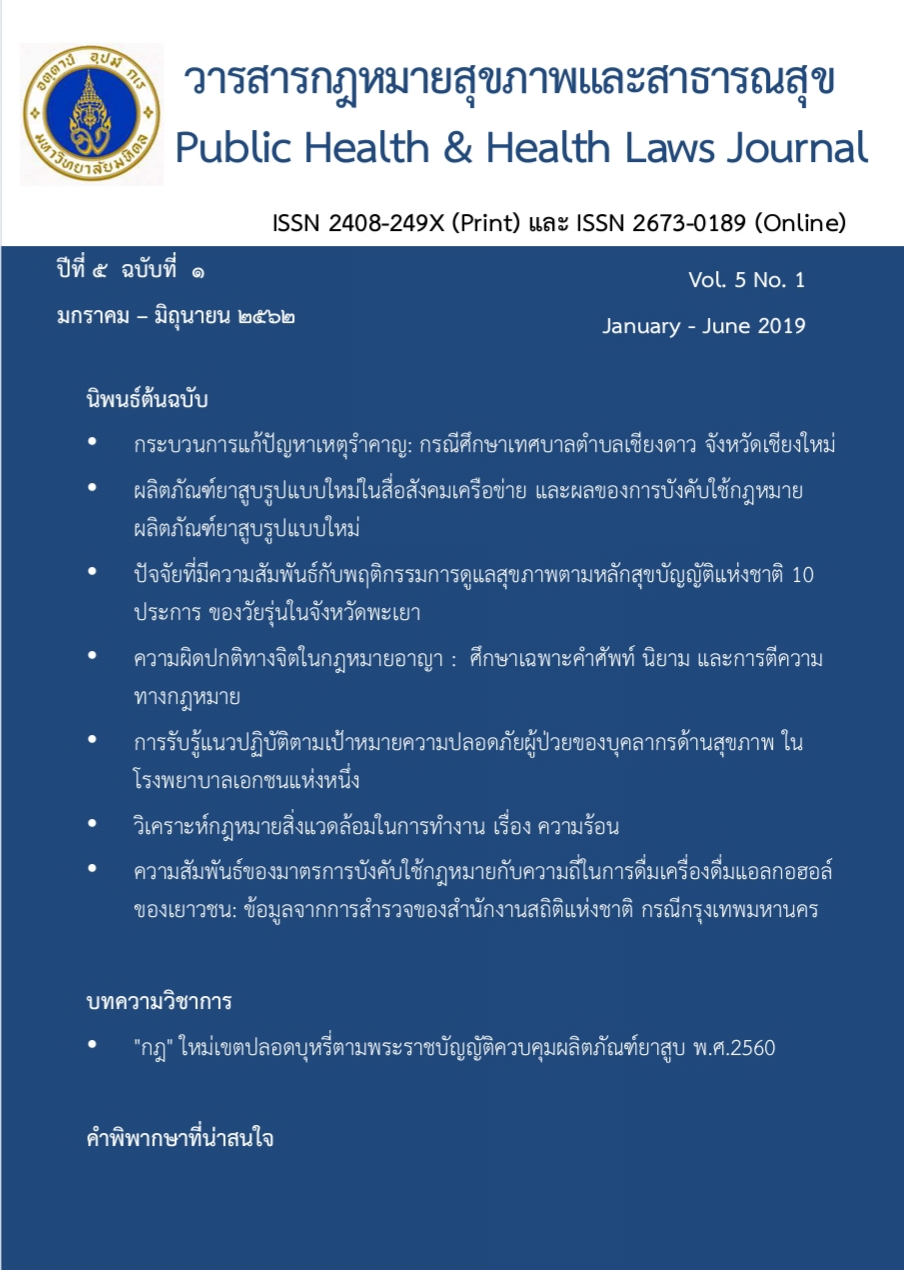Mental disorder in criminal law: terminology, definitions and interpretations
Keywords:
mental disorders, insanity, mental illness, mental retardation, criminal lawAbstract
This research aimed to study vocabulary and meanings in society, law and medicine related to mental disorders, to study the terminology, definitions and legal interpretations of mental disorders in Thai and foreign law, to propose guidelines for the use of terminology, definitions, and legal interpretations of mental disorders in criminal law. Moreover, this research aims to propose guidelines to amend the Criminal Code in relation to mental disorders.
The method of this study was a qualitative research and a documentary research by analyzing the documents from provisions of law, court judgments, textbooks, books, scholarly documents, research papers and others related information.
The research found that the key words in Thai criminal law related to mental disorders include “Wikoncharit” or "Insanity" means incomplete legal capacity due to mental disorders. "Rokchit" refers to the psychosis symptom in psychiatry, " Chit Bokphrong” refers to mental disorders caused by neurological disorders and " Chit Fanfuean " refers to other mental disorders other than the two types above. The definition of the mental disorder in the Thai criminal law refers to the defective or incomplete ability in conscience or self-control due to mental disorders. The criminal law defines mental disorder based on social beliefs, evidence, and legal reasons. This research suggests that the criminal law should use the only one legal term to refer to all mental disorders. The definition of mental disorder in the Thai criminal law should be used in accordance with the Mental Health Act, B.E. 2551 but should not include substance-related disorder.
References
จารุวรรณ อมรศิลสวัสดิ์. (2558). ผู้ป่วยจิตเวชกับปัญหาการดำเนินคดีอาญา. วารสารร่มพฤกษ์ มหาวิทยาลัยเกริก, 33(3), 32-50.
ณรงค์ สุภัทรพันธุ์. (2532). ความหมายของคำว่า “จิตฟั่นเฟือน” ทางจิตเวชศาสตร์และทางกฎหมาย. วารสารสมาคมจิตแพทย์แห่งประเทศไทย, 30(3), 85-95.
ณัฐวุฒิ อรินทร์. (2557). การประกอบอาชญากรรมกับความสามารถรู้ผิดชอบของผู้กระทำผิดนิติจิตเวช. (วิทยานิพนธ์ปริญญามหาบัณฑิต, มหาวิทยาลัยมหิดล).
ตวงพร งามไพบูลย์. (2558). มาตรการทางกฎหมายเพื่อพิสูจน์ความผิดปกติทางจิตขั้นรุนแรงขณะกระทำความผิดอาญา. (วิทยานิพนธ์ปริญญามหาบัณฑิต, จุฬาลงกรณ์มหาวิทยาลัย).
นันทวัช สิทธิรักษ์. (2559). จิตเวชศิริราช DSM-5. พิมพ์ครั้งที่ 2. กรุงเทพฯ: มหาวิทยาลัยมหิดล.
ประภาส อุครานันท์, วีระเดช วีระพงษ์เศรษฐ์. (2541). ผู้ป่วยโรคจิตกับอาชญากรรมรุนแรง. กรุงเทพฯ: โรงพยาบาลนิติจิตเวช.
ปรีชา วงศ์พุทธา, ราณี ฉายินทุ. (2537). การศึกษาความสัมพันธ์ระหว่างการพิพากษาของศาลกับผลการตรวจวินิจฉัยของแพทย์ในผู้กระทำผิดทางอาญาที่มีปัญหาทางจิตเวช. วารสารโรงพยาบาลนิติจิตเวช, 3(2), 33-49.
ภิญญารัตน์ ศักดิ์วัฒนเวคิน. (2539). การศึกษาปัจจัยต่างๆที่สัมพันธ์กับผลการพิพากษาของศาลต่อผู้ป่วยโรคจิตกระทำผิดฐานฆ่าผู้อื่น. (วิทยานิพนธ์ปริญญามหาบัณฑิต, จุฬาลงกรณ์มหาวิทยาลัย).
รณชัย คงสกนธ์. (2551). ตำรานิติจิตเวชศาสตร์. พิมพ์ครั้งที่ 2. กรุงเทพฯ: หจก.บางกอกบล็อก.
วนัทดา ถมค้าพาณิชย์ และดวงตา ไกรภัสสร์พงษ์. (2552). ความเห็นของจิตแพทย์ต่อการดำเนินคดีอาญา. วารสารสุขภาพจิตแห่งประเทศไทย, 17(2), 118-128.
วิฑูรย์ อึ้งประพันธ์. (2533). วิกลจริต จิตบกพร่อง โรคจิต จิตฟั่นเฟือนในแง่กฎหมาย. วารสารอัยการ, 13(150), 37-55.
วีระ เขื่องศิริกุล. (2555). ประวัติศาสตร์จิตเวชศาสตร์. กรุงเทพฯ: ราชวิทยาลัยจิตแพทย์แห่งประเทศไทย.
ศกุนา เก้านพรัตน์. (2551). มาตรการทางกฎหมายสำหรับผู้ที่มีสภาพจิตไม่ปกติ: ศึกษากรณีการดำเนินคดีอาญา การรับโทษทางอาญา และการคุ้มครองสังคม. (วิทยานิพนธ์ปริญญามหาบัณฑิต, จุฬาลงกรณ์มหาวิทยาลัย).
สุพัฒนา เดชาติวงศ์ ณ อยุธยา. (2536). ประวัติจิตเวชศาสตร์สากล. ใน เกษม ตันติผลาชีวะ. ตำราจิตเวชศาสตร์. พิมพ์ครั้งที่ 2. กรุงเทพฯ: โรงพิมพ์มหาวิทยาลัยธรรมศาสตร์.
แสวง บุญเฉลิมวิภาส. (2551). ผู้ป่วยจิตเวช: ความเข้าใจที่ต่างกันระหว่างนักกฎหมายกับจิตแพทย์. จุลนิติ, 5(3), 35-54.
Colton CW, Manderscheid RW. (2006). Congruencies in increased mortality rates, years of potential life lost, and causes of death among public mental health clients in eight states. Prev Chronic Dis, 3(2), A42.
Frances AJ, Widiger T. (2012). Psychiatric diagnosis: lessons from the DSM-IV past and cautions for the DSM-5 future. Annu Rev Clin Psychol, 2012(8), 109-30.
Halifeh H., Johnson S., Howard L., Borschmann R., Osborn, D., Dean K., Moran P. (2015). Violent and non-violent crime against adults with severe mental illness. British Journal of Psychiatry, 206(4), 275-282.
Michel Foucault. (1961). Madness and Civilization: A History of Insanity in the Age of Reason. Richard Howard Vintage Books. New York: A Division of Random House.
Offer D. and Melvin S. (1984). Normality and the life cycle: a critical integration. New York: Basic Books.
Pudtan Phanthunane, Theo Vos, Harvey Whiteford and Melanie Bertram. (2012). Improving mental health policy in the case of schizophrenia in Thailand: evidence-based information for efficient solutions. BMC Public Health, 12(Suppl 2), A32.
Rueve ME, Welton RS. (2008). Violence and mental illness. Psychiatry (Edgmont), 5(5), 34-48.
Szasz, T. (1987). Insanity: The Idea and its Consequences. New York: Wiley.
Walvisch J. (2017) Defining “mental disorder” in legal contexts. International Journal of Law and Psychiatry, 52(20), 7–18.
Wilson B. (1995). Legal Straitjackets: When Reason Fails: Law and Mental Illness. In Selby H. (ed.). Tomorrows Law. Sydney: Federation Press.
World Health Organization. (2018). Mental health atlas 2017. Geneva: World Health Organization.
Downloads
Published
How to Cite
Issue
Section
License
Disclaimer and Copyright Notice
The content and information presented in articles published in the Journal of Law and Public Health Policy represent the opinions and sole responsibility of the respective authors. The editorial board does not necessarily agree with or assume any responsibility for the views expressed.
All articles, data, content, images, and other materials published in the Journal of Law and Public Health Policy are the intellectual property of the journal. Any individual or organization wishing to reproduce, distribute, or otherwise use the entirety or any part of such materials must provide proper citation.





